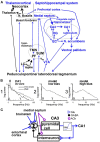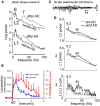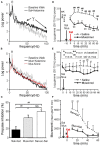Medial Septum Modulates Consciousness and Psychosis-Related Behaviors Through Hippocampal Gamma Activity
- PMID: 35874429
- PMCID: PMC9301478
- DOI: 10.3389/fncir.2022.895000
Medial Septum Modulates Consciousness and Psychosis-Related Behaviors Through Hippocampal Gamma Activity
Abstract
Abnormally high-amplitude hippocampal gamma activity (30-100 Hz) in behaving animals is seen after a hippocampal seizure, following injection of phencyclidine (PCP) or ketamine, and transiently in a delirium stage during induction of general anesthesia. High-amplitude hippocampal gamma activity in behaving rats is associated with hyperactive behavior and impairment in sensorimotor gating and sensory gating. The medial septum is necessary for the high-amplitude gamma activity and abnormal behaviors observed following a hippocampal seizure or injection of PCP/ketamine. Glutamatergic projection of the hippocampus to the nucleus accumbens (NAC) and dopaminergic transmission in NAC is necessary for abnormal behaviors. Large hippocampal gamma waves are suggested to contribute to seizure-induced automatism following temporal lobe seizures, and the schizophrenia-like symptoms induced by PCP/ketamine. Low-amplitude gamma activity is found during general anesthesia, associated with loss of consciousness in humans and loss of righting reflex in animals. Local inactivation or lesion of the medial septum, NAC, and brain areas connected to the septohippocampal-NAC system attenuates the increase in hippocampal gamma and associated behavioral disruptions induced by hippocampal seizure or PCP/ketamine. Inactivation or lesion of the septohippocampal-NAC system decreases the dose of anesthetic necessary for gamma decrease and loss of consciousness in animals. Thus, it is proposed that the septohippocampal-NAC system serves to control consciousness and the behavioral hyperactivity and neural dysfunctions during psychosis.
Keywords: gamma waves; general anesthesia; hippocampal seizure; ketamine; schizophrenia.
Copyright © 2022 Leung and Ma.
Conflict of interest statement
The authors declare that the research was conducted in the absence of any commercial or financial relationships that could be construed as a potential conflict of interest.
Figures



Similar articles
-
The medial septum mediates impairment of prepulse inhibition of acoustic startle induced by a hippocampal seizure or phencyclidine.Behav Brain Res. 2004 Nov 5;155(1):153-66. doi: 10.1016/j.bbr.2004.04.010. Behav Brain Res. 2004. PMID: 15325789
-
Deep brain stimulation of the medial septum or nucleus accumbens alleviates psychosis-relevant behavior in ketamine-treated rats.Behav Brain Res. 2014 Jun 1;266:174-82. doi: 10.1016/j.bbr.2014.03.010. Epub 2014 Mar 12. Behav Brain Res. 2014. PMID: 24632470
-
Medial septum modulates hippocampal gamma activity and prepulse inhibition in an N-methyl-d-aspartate receptor antagonist model of schizophrenia.Schizophr Res. 2018 Aug;198:36-44. doi: 10.1016/j.schres.2017.07.053. Epub 2017 Aug 8. Schizophr Res. 2018. PMID: 28801194 Review.
-
Dual Effects of Limbic Seizures on Psychosis-Relevant Behaviors Shown by Nucleus Accumbens Kindling in Rats.Brain Stimul. 2016 Sep-Oct;9(5):762-769. doi: 10.1016/j.brs.2016.05.006. Epub 2016 May 18. Brain Stimul. 2016. PMID: 27267861 Free PMC article.
-
The role of the hippocampo-prefrontal cortex system in phencyclidine-induced psychosis: a model for schizophrenia.J Physiol Paris. 2013 Dec;107(6):434-40. doi: 10.1016/j.jphysparis.2013.06.002. Epub 2013 Jun 17. J Physiol Paris. 2013. PMID: 23792022 Review.
Cited by
-
Septal stimulation attenuates hippocampal seizure with subregion specificity.Epilepsia Open. 2024 Aug;9(4):1445-1457. doi: 10.1002/epi4.12983. Epub 2024 Jun 3. Epilepsia Open. 2024. PMID: 38831626 Free PMC article.
-
Neurometabolic and structural alterations of medial septum and hippocampal CA1 in a model of post-operative sleep fragmentation in aged mice: a study combining 1H-MRS and DTI.Front Cell Neurosci. 2023 Jun 2;17:1160761. doi: 10.3389/fncel.2023.1160761. eCollection 2023. Front Cell Neurosci. 2023. PMID: 37333891 Free PMC article.
-
Brain Microtubule Electrical Oscillations-Empirical Mode Decomposition Analysis.Cell Mol Neurobiol. 2023 Jul;43(5):2089-2104. doi: 10.1007/s10571-022-01290-9. Epub 2022 Oct 7. Cell Mol Neurobiol. 2023. PMID: 36207654 Free PMC article.
References
-
- Adler L. E., Waldo M. C., Freedman R. (1985). Neurophysiologic studies of sensory gating in schizophrenia: comparison of auditory and visual responses. Biol. Psych. 20, 1284–1296. - PubMed
Publication types
MeSH terms
Substances
Grants and funding
LinkOut - more resources
Full Text Sources
Medical

